

Telecom Innovations: Breaking Down the Barriers to DevSecOps
Fri, 02 Sep 2022 15:16:44 -0000
|Read Time: 0 minutes
DevOps—the fusion of software development with IT operations—has been a best practice among development and IT teams for quite some time now. More recently, the need to integrate security within the DevOps process has made DevSecOps the new gold standard for software development and operations. While this may seem like great idea on paper, but what happens when the developers, security architects, and network ops teams are not part of the same company? Telecom networks are typically developed by multiple suppliers.
In many cases, telecom software is developed by external vendors in a walled fashion where Communication Service Providers (CSPs) have little visibility into the development process.
The need to adhere to strict telecom standards and models such as Enhanced Telecom Operations Map (eTOM) and European Telecommunications Standards Institute (ETSI) also compounds the complexity of DevSecOps in telecom. The third barrier is managing a single DevSecOps pipeline while juggling multiple generations of network equipment and configurations
Removing barriers with open telecommunications
What happens when there is no unified environment to support DevSecOps processes? You build one. That’s what Dell Technologies did with the recent launch of its Open Telecom Ecosystem Lab (OTEL). With OTEL, telecom operators and software and technology partners can work together using an end-to-end systems approach that spans seamlessly across vendor, lab, staging, and production environments.

OTEL provides everything that CSPs and vendors need to support DevSecOps processes with the new Solutions Integration Platform (SIP) including:
- Continuous integration across environments
- Continuous deployment of all new software releases in a controlled manner
- Continuous testing to ensure that updates/changes are mostly (80+ percent) automated
- A closed-loop system where pipeline decisions are driven by real-time data insights
A holistic approach to integration, deployment, and testing
In the last few years, there has been a big push to incorporate continuous integration/deployment (CI/CD) pipelines in the telecommunications industry. This push has been met with resistance because of the following challenges:
- Walled software development,
- Multi-generation network technology,
- and stringent requirements around performance, reliability, and security.
Telecom operators’ enterprise customers also have limited involvement in software development despite a deep interest in the functionality and outcomes of that software. For the operaters, becoming a part of the software development process can mean getting services to market sooner with a finished product that meets the needs of end users.
One of the primary goals of OTEL is to deliver telecom innovation as a platform, providing three core capabilities:
- Integrated software development: Although telecom software vendors will ultimately define and control this process, OTEL offers them a unified packaging template and test specifications that can be shared easily across CSP and partner ecosystems.
- Lab and staging environment: Once the software is validated and security-hardened, it can be deployed in the OTEL lab and pre-deployment environments to identify and fix potential issues before deployment in the production network.
- Replicated pre/production environment: OTEL can replicate the production environment to ensure seamless integration between all components.
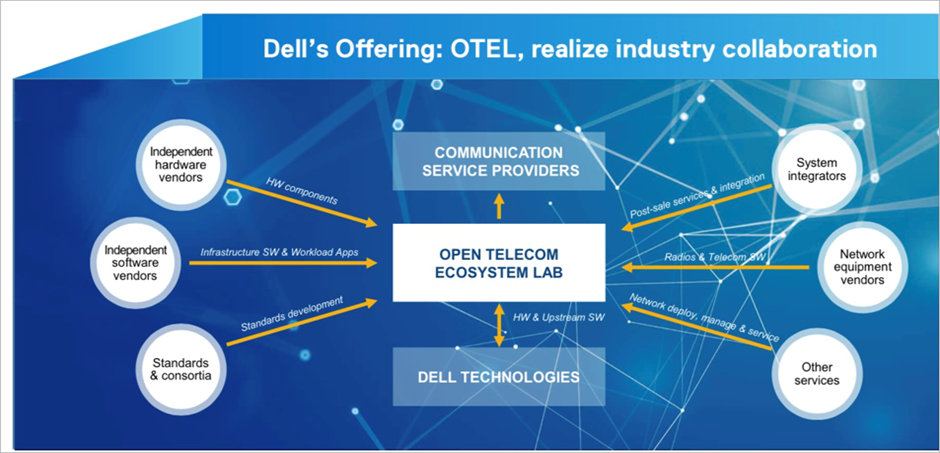
Addressing the telco security challenges
Telecom Networks are critical infrastructure and have a unique requirements on security driven by service needs and SLA’s, strong regulations and geographical laws, and cyber and data privacy . For 5G and cloud solutions, which involve many vendors, it is important to build a zero trust security architecture that can be validated and tested in a automated CI/CD driven approach. It is also important to enable security mechanisms that can automate security tests across each layer of network. These include:
- Telecom network layer security
- Service layer security
- End point security
- Data platforms and close loop automation
Integrating both the functional and non-functional requirements of telecom networks including security, reliability, and performance is the unique challenge Dell is trying to address through its state of art OTEL . By reducing the complexity of telecom software development and ensuring better integration and collaboration, OTEL is giving CSPs and their partners the agility and security they need to deliver the next generation of 5G and edge solutions.
To learn more about OTEL and how you can take advantage of OTEL’s state-of-the-art lab environment, contact Dell at Open Telecom Ecosystem Labs (OTEL.)
Author information
Saad Sheikh is a APJ Lead Systems Architect for Orchestration and NextGen Ops in Dell Telecom Systems Business (TSB) . In this role he is responsible to support partners, NEP’s, and customers to simplify and accelerate networks transformation to open and dis-aggregated infrastructures and solutions (5G, edge computing, core, and cloud platforms) using Dell’s products and capabilities that are based on multi cloud, data driven, ML/AI supported and open ways to build next generation Operational capabilities. In addition as part of Dell CTO team he represent Dell in Linux Foundation , TMforum , GSMA, ETSI, ONAP, and TIP. He has more than 20 years of experience in industry in telco's system integrators, consulting business, and with telecom vendors where he has worked on E2E Telecoms systems (RAN, Transport, Core, Networks), cloud platforms, automation and orchestration, and intelligent networking.

Related Blog Posts

Accelerate intelligent operations using AIOps for cloud native networks
Tue, 30 Jan 2024 17:07:35 -0000
|Read Time: 0 minutes
Dell Technologies infrastructure blocks enable telco customers to adopt telco-centric AIOps to improve operations.
Communication service providers (CSPs) are racing towards fully autonomous networks and consider automation and artificial intelligence (AI) adoption in telecom networks to be of great value. According to the latest industry insights report published by TM Forum® (New-generation intelligent operations: the service-centric transformation path), most CSPs aim to achieve Level-3 automation (conditional autonomous networks) and Level-4 automation (highly autonomous networks) by 2025. There is increased interest in accelerating Level-5 automation (AI-driven automation) using AIOps solutions.
However, telco adoption of AI-centric automation is not easy primarily because most CSPs operate a geographically distributed brownfield network and manage a multi-generation fleet of infrastructure and resources. CSPs also operate at different scales which means there is no simple, “cookie-cutter” approach towards AI-driven operations (AIOps).
In addition, CSPs adopt solutions based on clearly defined, standard telecom architectures like ETSI® (European Telecommunications Standards Institute), TM Forum® (Telecom Management Forum), 3GPP® (3rd Generation Partnership Project), and O-RAN (Open RAN alliance). CSPs also source solutions that can interwork and interoperate at a global scale. Finally, CSPs expect these solutions to fully integrate into their brownfield environments.
Hence, there is a requirement to build an outcome-based solution that supports existing operations. At the same time, the solution must enable them to accelerate the adoption of the next era of operations (based on data-driven insights and artificial intelligence).
How to adopt AIOps-based, intelligent operations for networks
CSPs are working alongside many standards bodies (especially the TM Forum®) to accelerate automation towards Level-4 (full-service orchestration and automation) and Level-5(AI-driven automation). However, there still lacks a clear path for applying these principles to large-scale networks. Building the right architecture starts from clear requirements quantification.
The right AIOps solution that is designed for CSPs must align with unique telco-specific requirements on:
- Distributed topology maps. Telco networks are being purpose-built and deployed to deliver critical and differentiated services for many decades. These networks are not like data centers but instead a fleet of resources—such as home networking, fiber, transport, radio, core, cloud, and WAN services. Topology alignment (like A/B plane, Ring) and service resilience are key requirements.
- Multi-vendor and multi-generation. Typically, CSPs operate a brownfield network over multiple generations. Most of these systems have an extended lifetime of 10 to 15 years. So, the solution should not only be future-proof but also cater to the requirements of existing deployed solutions.
- Data models. CSP networks, by nature, are highly protected—with network data existing in many silos. Network operations also follow a hierarchical, process-based delivery that is defined by Network Operations Centers (NOCs). In addition, data knowledge is based on tools and systems that vendors provide.
Given that AIOps systems are already proven and prevalent in the Cloud and IT industries, these systems and solutions must be adapted to meet CSP requirements.
AIOps in networks should strictly align with both telecom standards and network-specific needs—delivering the following capabilities:
- Process alignment. The current operational model of a telco cloud heavily relies on an operational team knowledge base and expertise. So, it is not just about data but also the unique experience of CSP operations—which are important.
- Data access. CSPs follow strict security and privacy requirements where customer data and information cannot be exposed. So, in order to adopt AIOps, data access models must be standardized to ensure AIOps use cases can retrieve data as per approved policies.
- Tuning. Because CSP-deployed networks must operate for extended periods of time, current solutions—which follow strict AI rules—cannot meet their future requirements. Therefore, AIOps systems must be adaptive.
- Scalability. CSPs operate at different scales starting from Tier-1 (many geographies) to Tier-2 (small scale). Therefore, telco-specific AIOps systems should offer a T-shirt sizing approach.
Accelerate the network AIOps journey
Today, many CSPs have already deployed small-scale AIOps solutions. However, most of these solutions are not highly aligned with telco-specific requirements—resulting in many silos that are hard to manage and scale. Further, CSPs must invest heavily in terms of time and cost to do Life Cycle Management (LCM) of these solutions. It all translates to barriers towards cloud native transformation.
Just as telco cloud CSPs have adopted standards like ETSI®, LFN® (Linux Foundation Networking) and ORAN® (Open RAN), there is a requirement to adopt a standard architecture for the Telco Multicloud AI foundation that can smoothly integrate with brownfield networks. Below are the key capabilities of an AI-centric telco platform that can enable AIOps use cases:
- Horizontal AI platform. The telco-centric AI platform should enable a composable platform that consists of:
- AIOps application layer: hosting various AIOps tasks
- Machine Learning (ML) layer: adopting specific ML models suitable for AIOps
- Knowledge layer: integrating the NOC processes and knowledge of CSPs
- Data layer: resolving any data silos in networks
- Physical layer: managing telecom networks using fully decoupled infrastructure automation
- Distributed data ingestion. The telco-centric AI platform should ingest data from fully distributed networks—delivering both reactive (respond after event occurs) and proactive (predictive) use cases on:
- MOP integration: Existing MOP and workflows must be integrated.
- Operational processes integration: Existing NOC processes must be integrated in data pipelines.
- Cloud native MLOps and AIOps capabilities. Telcos must supplement operational in-house knowledge with ML models and find a way to tune and extend it. Different models must be integrated. A systematic integration of knowledge systems with ML models (in a use case-driven approach) is required for success in network operations.
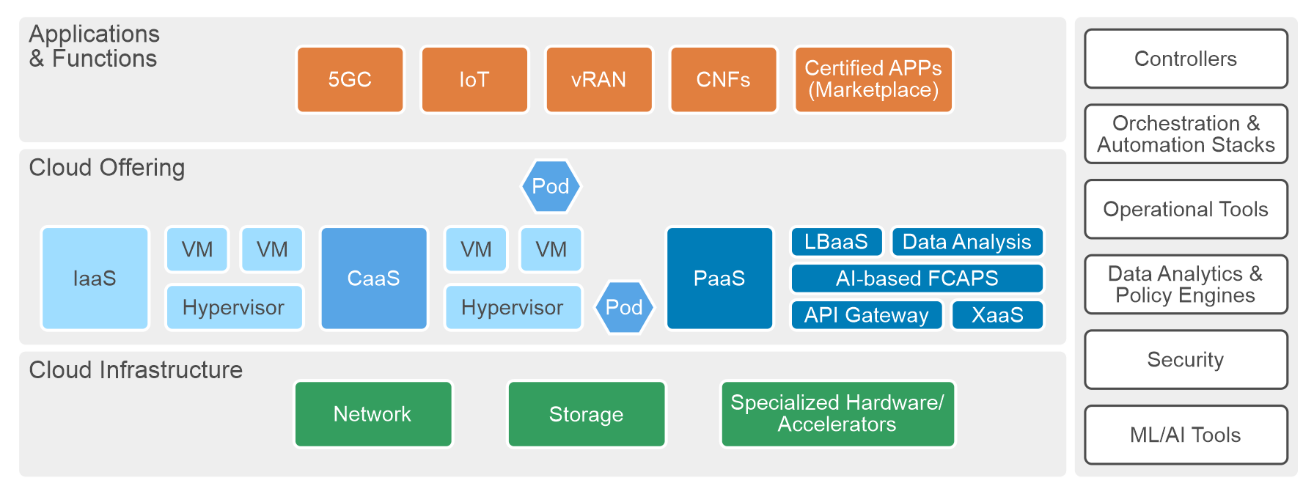
Figure: Reference architecture for AIOps-driven telecom network
How to adopt AIOps operations using telecom infrastructure blocks
Dell Technologies has worked closely with leading cloud partners, including Wind River® and Red Hat®, to bring forward an operationally ready telco cloud platform. This platform is thoroughly tested, validated, and automated to deliver telco AIOps use cases. This platform also accelerates a CSP’s adoption of zero-touch operations while consistently aligning to telecom standards and frameworks.
The Dell Technologies Telecom Multicloud Foundation flexibly transforms network operations towards programmable infrastructure using a consistent tooling and AIOps capabilities approach.
Because the platform supports multiple versions and offers with various partners, CSPs can operate all such foundational infrastructure blocks as one. Through the following key capabilities, our solution can quickly transform operational models and processes and enables agile MLOps (required in a telco environment).
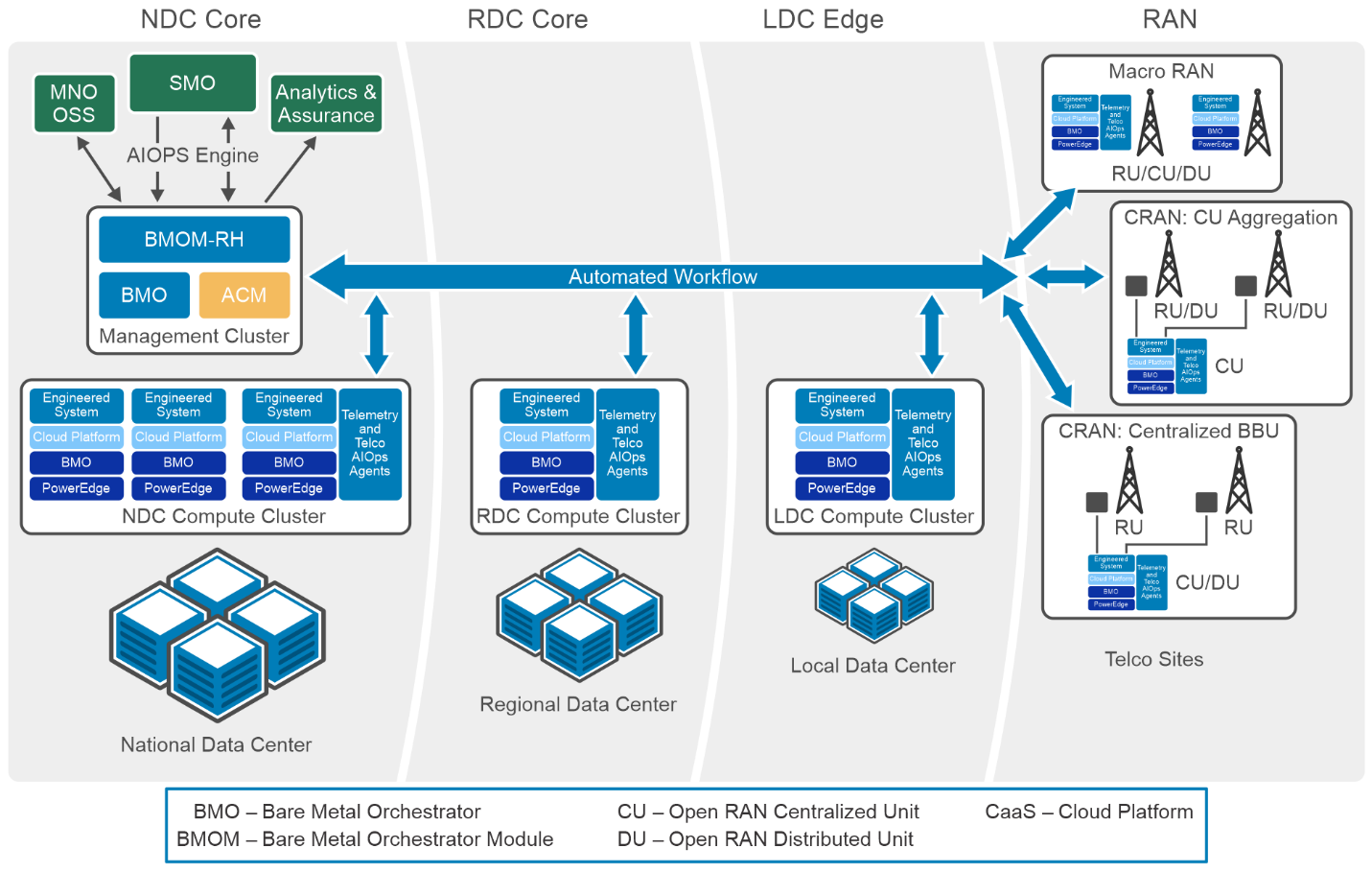
Figure: Solution architecture for AIOps Foundation
To support the unique CSP requirements to adopt AIOps and a cloud operating model, our Telecom Infrastructure Blocks provide the following key capabilities:
- Consistent platform. The first challenge is to deliver a standard and consistent platform that can integrate all layers above—abstracting the complexities of multiple technologies and components from different vendors.
- Cloud native MLOps. AIOps use cases require cloud-type agility towards data and ML. Our current version of infrastructure blocks delivers a ready platform. In future releases, we plan to enable AI enhancements (like Openshift® AI) on top of this platform. This means CSPs can build, program, and manage all their ML models and capabilities in the same way they manage cloud resources.
- Autonomous operations. Adopting data-centric architectures and ML approaches provides CSPs a smooth evolution path from their current automation approaches to an AI-centric automation that is aligned with the telco future mode of operations (FMO).
- Data-driven architecture: The automation architecture is data-driven and distributed, so data can be tapped from edge and regional sites—enabling real-time use cases and data-driven operations.
- Automated fault management: The FMO follows zero-touch and intent-driven networks. Our solution is fully aligned with this vision that enables all cloud platforms to use declarative workflows. The solution also enables all northbound integration towards orchestration and assurance systems.
- Single pane for DevOps and MLOps operations: As CSPs adopt ML/AI frameworks to deliver AIOps use cases, there is an increasing requirement to integrate and operate both DevOps and MLOPs as one. In addition, AIOps platform capabilities must be enabled in telco cloud platforms. Doing so provides a single management and observation platform.
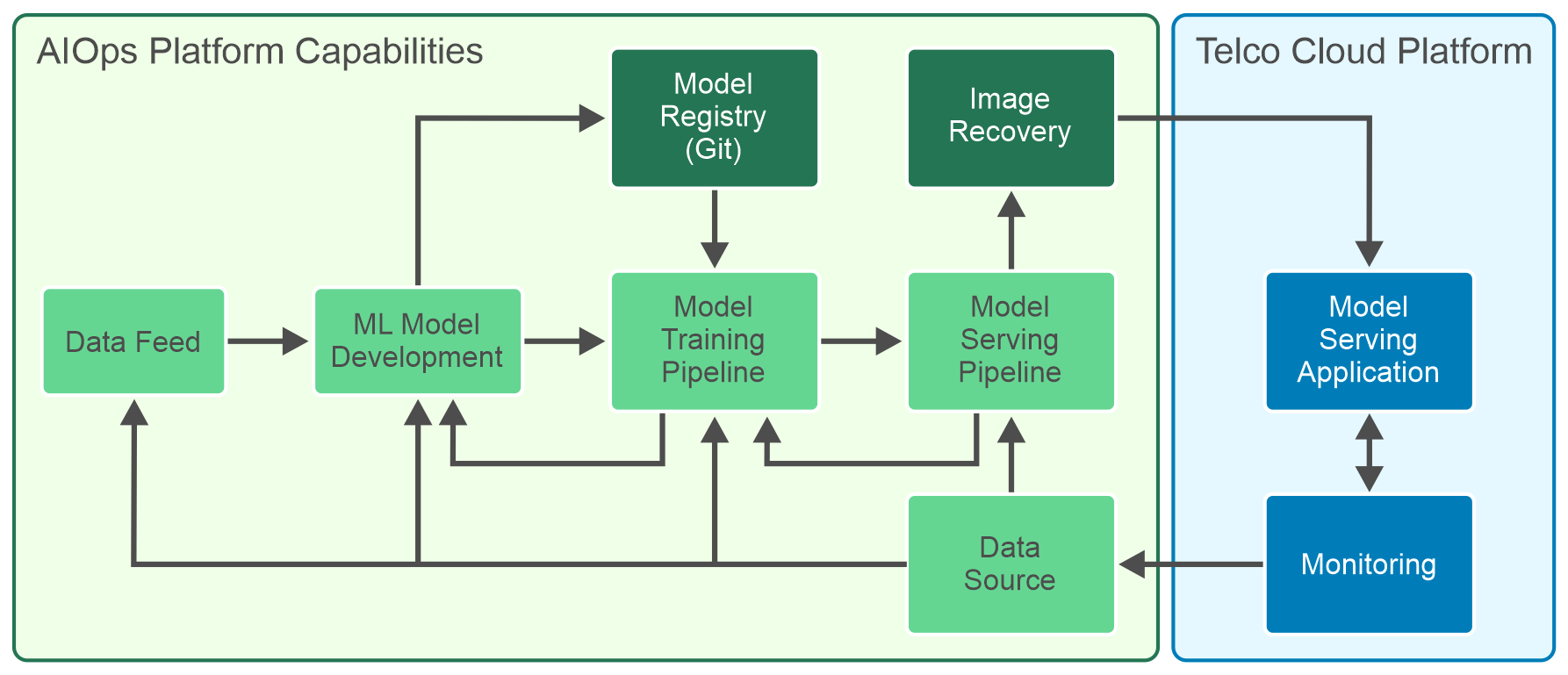
Figure: DevOps and MLOps workflow using AIOps platform capabilities
Dell Technologies developed Telecom Multicloud Foundation and Telecom Infrastructure Blocks to accelerate telco cloud transformation. Our engineered and factory-integrated system delivers a consistent platform. This platform is ready to deliver telco-specific AIOps use cases that are fully aligned with telecom architectures—enabling our customers to accelerate AIOps solutions in networks.
Visit the Dell Telecom Multicloud Foundation site to learn more about our solution.

Improving Network Operations and Observability for Cloud-Native Networks
Tue, 24 Oct 2023 14:35:04 -0000
|Read Time: 0 minutes
Communication service providers (CSPs) are rapidly modernizing their networks towards cloud-native and open architectures. However, as the scale of these deployments increases, so does the ever-growing concern about operational management and complexity.
According to the latest report by TM Forum on Autonomous Networks, most CSPs still manage and operate their networks at level-2 automation. This level is where most tasks are completed using statically configured rules, limiting a CSPs ability to monetize Network transformation benefits. As a result, major customers are investing in automizing their operations in order to move to level-3 automation at scale (from 13 percent today to 36 percent by 2026) to achieve zero touch closed-loop operations through dynamic and programmable policies. Level-3 automation will also enable pathways that accelerate adoption towards level-4 automation (from 4 percent today to 23 percent by 2026), which is ML and AI-centric.
Intelligent operations offer several business benefits, including improving return through better TCO, or enhancing Time to Value (TTV) for offerings and further improving resource efficiency. However, there is no cookie-cutter approach to improving network operations. The primary challenge CSPs face is that a significant lot operates a brownfield network and manages a fleet of networks and resources. As a result, building a reference architecture that aligns with their existing operations—and simultaneously accelerates the adoption of the next era of operations—is a complex challenge.
Simplifying Network Operations and Observability
Today, many CSPs are working to address the right solution and platform to optimize operational models. However, these efforts usually result in be-spoke solutions that are hard to manage and scale. CSPs also invest heavily in both time and cost to perform Life Cycle Management (LCM) of these solutions. These challenges create barriers to reaping Cloud and Network transformation benefits.
Dell Technologies has worked closely with leading cloud partners, including Wind River and Red Hat, to offer an operationally ready Telco Cloud platform as part of the Dell Telecom Multi-Cloud Foundation offer. This solution includes co-engineered building blocks referred to as Telecom Infrastructure Blocks, which support zero-touch operations and closed-loop automation. By automating the deployment and life-cycle management of the cloud platforms used in a telecom network, Dell’s Telco Cloud reduces operational costs while consistently meeting telco-grade SLAs.
Additionally, customers can optimize their infrastructures with a cloud platform of choice that is aligned end-to-end to workload vendor specifications and use cases, effectively transforming their operational models and processes. This solution not only streamlines telecom cloud design, deployment, and management with integrated hardware, software, and support, but also fully aligns with a telco-centric operational model.
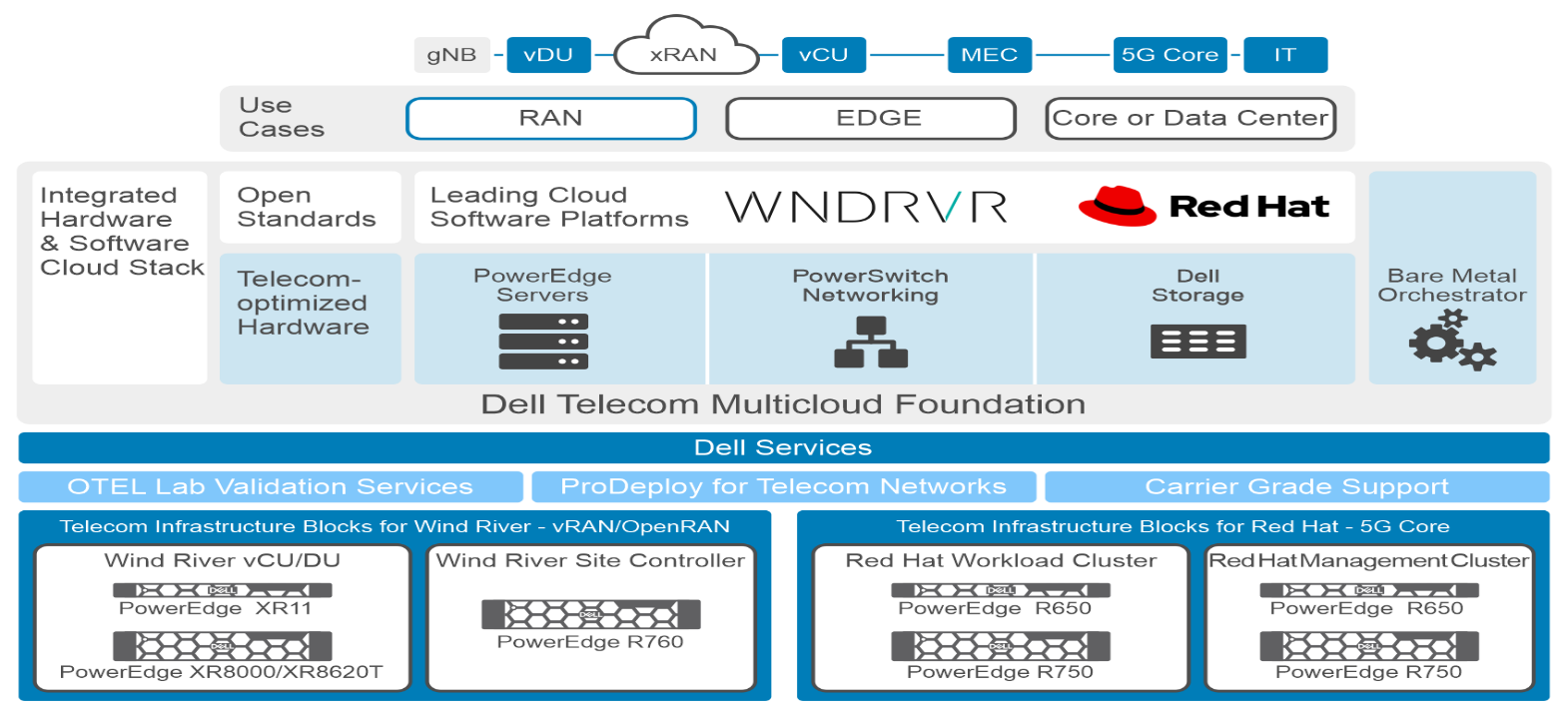
Telecom Infrastructure Blocks releases will be agile delivered with multiple yearly releases to simplify life cycle management. By the end of 2023, Dell Telecom Infrastructure Blocks will support workloads for Radio Access Network and Core Network functions with:
- Dell Telecom Infrastructure Blocks for Wind River, which will support vRAN and Open RAN workloads.
- Dell Telecom Infrastructure Blocks for Red Hat that initially target Core Network workloads.
To support CSPs’ operational transformation that addresses optimal cost structure, telecom SLAs, and their ability to automate and orchestrate at scale, Dell Telecom Infrastructure Blocks provide the following key capabilities:
- Interoperability – Operating all telco cloud platforms as one abstracts all the complexities from multiple technologies and multiple components from different vendors. This allows CSPs to run and manage the entire platform together.
- Lifecycle management – Typically, a telco network requires long life-cycle time commitments and the ability to coordinate multiple systems with different versions. Dell Telecom Infrastructure Blocks address these issues by providing configuration changes and version alignment for firmware, BIOS, CaaS software and more.
- Closed-loop operations – Operational transformation is evolving towards zero-touch. This requires a new strategic platform that can de-couple infrastructure from application and enable smooth integration with application orchestration and assurance systems following a telco future mode of operations (FMO).
Transforming Operations Using Telecom Infrastructure Blocks
Dell Telecom Multi-Cloud Foundation provides CSPs a platform-centric solution that promises full support and alignment toward CSP level-4 automation. CSPs can flexibly transform their operations to programmable infrastructure using a consistent tooling and capabilities approach.
Through multiple versions and offers with various partners, CSPs can operate all such foundational infrastructure blocks as one through the following key capabilities:
- Remote upgrades – This solution follows a consistent tooling and operational model, which allows operational teams to operate full telecom cloud platforms at scale and enables seamless use from central orchestration tools.
- Operational automation – The Day2 and NOC (Network Operations Center) Telco cloud platform operations can be performed at scale in an automated manner. For CSPs, this means that whole platform can be operated as one following a true IaC (Infrastructure as code) and Programmable infrastructure principle using declarative blueprints. Similarly, patching and LCM options are possible using Dell and CaaS partner-offered tools. Use cases of automatic upgrades and CI/CD of day-n patches and upgrades are also supported as per the road map.
- Single pane of glass – Customers are known to deploy different cloud stacks to optimally support different use cases (possibly runnin g workloads from various partners), which has led to an increasing requirement to operate all cloud stacks as one using a single pane of glass. This provides the operation team a single management and observation platform, which this solution not only supports along the road map, but also creates a unified layer for NOC teams to monitor and manage.
- Green network operations – As CSPs find ways to reduce carbon emissions, there is an increased interest in full observability and monitoring, along with actionable insights to optimize and tune cloud platforms. These areas are on the road map and will also be part of Dell Telecom Multi-Cloud Foundation solution.
- Data-driven architecture – For data to be tapped from core to edge to Radio Access Networks (RAN) the automation architecture used in this solution is data-driven and distributed, enabling real-time use cases and data-driven operations.
- Automated fault management – This solution is fully aligned with the future mode of operations, which follows zero-touch and intent-driven networks. This vision enables all cloud platforms to use declarative workflows and Northbound integration towards Service Management and Orchestration (SMO) and assurance systems.
- Brownfield operations – This solution aligns with CSPs brownfield requirements, which unlocks a range of benefits. These include the ability to integrate existing clusters, integrate existing CI/CD pipelines, and align with existing NOC tools and processes, enabling customers to operate and manage distributed and open infrastructure.
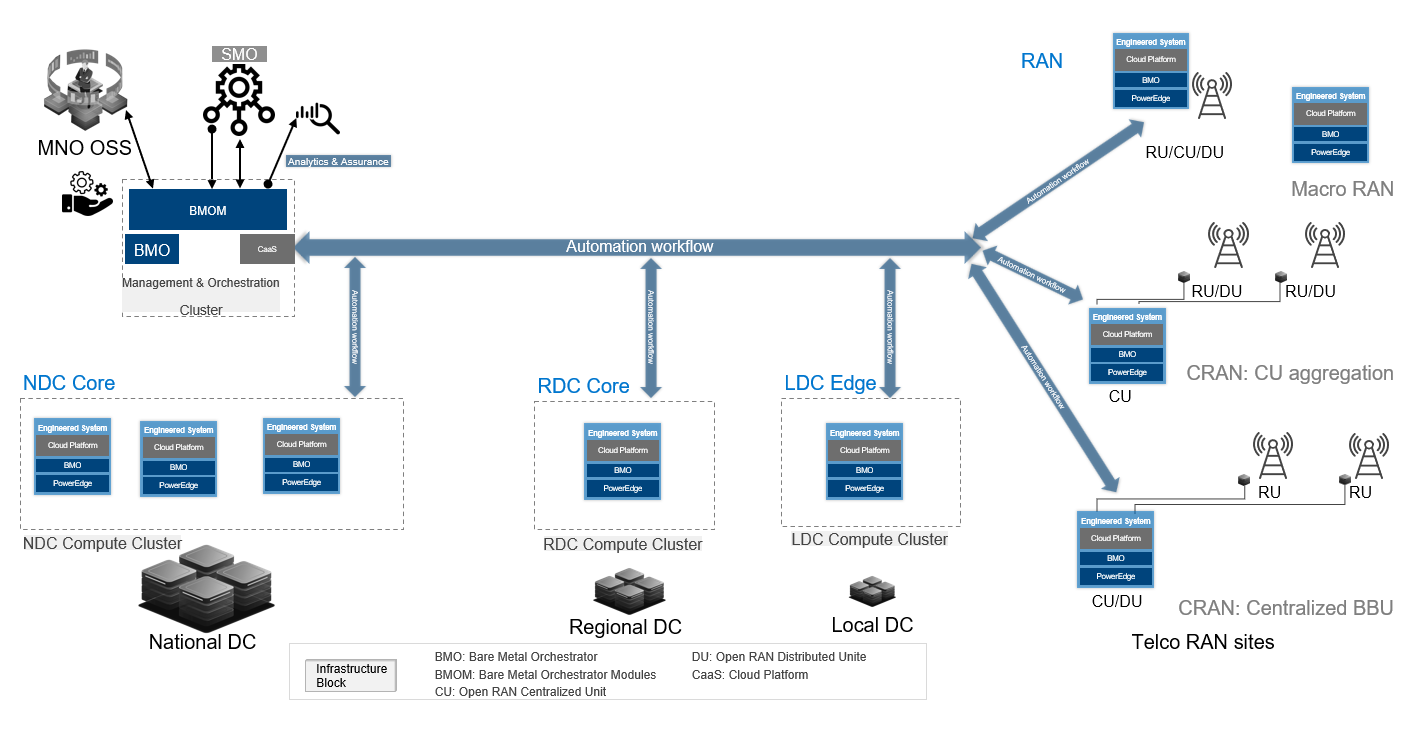
Dell Technologies developed Telecom Multi-Cloud Foundation and Telecom Infrastructure Blocks to accelerate 5G cloud infrastructure transformation. Telecom Infrastructure Blocks for Wind River and Red Hat delivers an engineered, validated, and factory-integrated Telco Cloud platform that is performance-optimized for RAN and Core use cases. It is also fully aligned for CSPs looking to accelerate Intelligent operations and evolution towards level-4 autonomous networks.
To learn more about this solution, visit the Dell Telecom Multi-Cloud Foundation solutions site.
This blog is co-authored with Abdullah Abuzaid, Technical Product Manager, and Anjali Bhatia, Technical Marketing Engineer at Dell Technologies.




